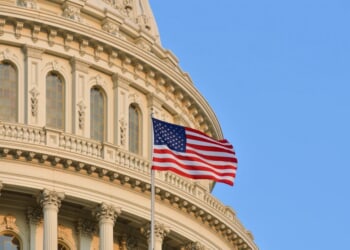If the United States falls behind Russia and China in South Asia, it won’t just forfeit clean energy leadership—it will forfeit the future of nuclear diplomacy in the region.
South Asia is racing to meet its rising power demand, which is projected to triple by 2050, while reducing reliance on fossil fuels. India ambitiously plans for net-zero by 2070. Pakistan plans to generate sixty percent of its electricity from renewables by 2030. Bangladesh follows closely with a forty percent target by 2041. While solar and wind are part of the solution, nuclear power—an emissions-free, base-load, reliable energy source—is increasingly viewed in the region as essential to meeting these targets.
India and Pakistan have operated nuclear plants for decades, but both are now planning massive expansions. India aims to grow its nuclear capacity from seven GW to 100 GW by 2047, while Pakistan plans to build thirty-two nuclear reactors by 2050.
China and Russia are capitalizing on this. Russia’s Rosatom is constructing six reactors at Kudankulam in India. China has financed and built every operational civilian reactor in Pakistan and is providing over $5 billion in loans to cover the costs for the latest units of Karachi’s Nuclear Power Plant. China is also providing support to build Pakistan’s largest nuclear plant to date, the Chashma 5. In Bangladesh, Russia is building the Rooppur Nuclear Power Plant, the country’s first.
These aren’t just energy projects. They’re long-term partnerships that bind South Asian countries to Chinese and Russian technology, financing, and fuel. Meanwhile, since building the Tarapur Atomic Power Station in India in the 1960s, the United States has not built or financially supported a single nuclear power plant in the region.
Why is the United States Lagging Behind?
The United States has the technological edge, especially in small modular reactors (SMRs) and microreactors, but the US faces a domestic regulatory environment that actively hinders international competitiveness.
Domestically, the United States’ nuclear sector’s biggest bottlenecks often emerge before construction even begins: from securing long-lead supply chain components to coordinating workforce training and navigating duplicative documentation requirements across agencies. Even demonstration-scale reactors like NuScale’s VOYGR have faced prolonged delays due to these challenges. For instance, while China plans to build ten GW of nuclear power for $27 billion, the US has spent over $35 billion on just two reactors with a combined capacity of 2.2 GW at Plant Vogtle. This underscores how preparation and permitting inefficiencies escalate costs and delay timelines.
Export hurdles are also a major barrier. The United States has not signed Section 123 nuclear cooperation agreements with most South Asian nations except India. These agreements are legally required frameworks that enable civil nuclear trade by establishing nonproliferation safeguards and terms of cooperation. Without them, American firms are restricted from exporting nuclear technology. Worse, U.S. government support for nuclear exports requires firms to run a gauntlet of more than twenty offices across eight federal agencies. Meanwhile, Russia and China offer full-spectrum deals, including construction, fuel, training, and financing.
However, these investments come with strings attached. Russia’s build-own-operate model can lock countries into long-term dependence on its technology and services, making them vulnerable to the Kremlin’s influence. Similarly, China’s track record of opaque financing and state-directed lending can saddle countries with debt and limit recipient countries’ autonomy.
That’s why it’s critical for the United States to clear its own investment hurdles and step up as a credible, transparent nuclear partner in South Asia.
Fuel Supply: The Essential Missing Piece in U.S. Competitiveness
A nuclear export strategy without reliable fuel services is incomplete, and that’s where the United States is currently falling short.
As of 2023, seventy-three percent of the enriched uranium used in U.S. reactors came from foreign sources, including twenty-seven percent from Russia. Russia controls roughly forty-four percent of global enrichment capacity. Meanwhile, the United States operates only one commercial enrichment facility, meeting just one-third of domestic needs.
South Asian countries that sign nuclear deals with Russia or China aren’t just getting reactors. They are also getting guaranteed fuel for decades. Russia delivered enriched uranium to Bangladesh in 2023 under a long-term supply agreement for the Rooppur project. China has similar arrangements with Pakistan.
In contrast, the United States is only beginning to rebuild its fuel infrastructure. After decades of underinvestment, it is now trying to restart domestic uranium conversion and enrichment capacity, including the production of high-assay low-enriched uranium (HALEU) for advanced reactors. Without a secure fuel supply, American nuclear exports remain incomplete and uncompetitive.
Additionally, the World Bank has maintained a de facto ban on financing nuclear energy since 2013, restricting the ability of developing countries to access loans for nuclear projects. This policy has particularly hurt American companies, which rely more heavily than their state-backed Chinese and Russian counterparts on multilateral development financing to enter emerging markets.
Why This Matters
This isn’t just about clean energy. It’s about global influence. South Asia is home to 1.8 billion people. Its future energy partners will shape the region’s long-term economic, diplomatic, and security relationships.
Right now, Russia and China are setting the rules of engagement. U.S. inaction is creating dependencies on authoritarian regimes and missing opportunities to promote American values and standards.
The United States has one clear advantage: innovation. SMRs, which are smaller, safer, and easier to deploy, could be ideal for South Asian grids. Pakistan is already exploring them, and India recently announced plans to build SMRs for industrial use and to repurpose coal infrastructure. In March 2025, the U.S. Department of Energy (DoE) approved regulatory clearance for Holtec International, a US firm, to transfer SMR technology to India under the 123 agreement. But unless the United States accelerates such efforts in the region, those markets will be locked up by others.
What the United States Should Do:
- Fix the licensing logjam: The U.S. Nuclear Regulatory Commission should streamline its licensing timeline, consolidate duplicative steps, and allow parallel approvals. Nuclear power plants, especially SMRs, can’t wait a decade to get built.
- Expand nuclear cooperation agreements: The United States should pursue 123 agreements with more South Asian countries beyond India to unlock legal export channels for American nuclear firms.
- Rebuild fuel supply chains: Congress and the DoE must accelerate investments in uranium conversion and enrichment to offer a credible alternative to Russian and Chinese fuel dominance.
- Support SMRs abroad: Pair U.S. SMR exports with full government support (i.e., training, safety partnerships, and public financing) to match the integrated packages offered by rivals.
- Lift financing barriers: Push to end the World Bank’s ban on nuclear energy lending. Without multilateral funding, American vendors will struggle to compete in emerging markets. Recent momentum to lift the ban is a welcome development
Conclusion
China and Russia are using nuclear energy to deepen their influence in South Asia. If the United States wants to stay relevant, it needs to fix its regulatory system, break financing barriers, and offer the kind of full-spectrum partnerships that the region is already receiving elsewhere. If the United States doesn’t act fast, it won’t just forfeit clean energy leadership—it will forfeit the future of nuclear diplomacy in South Asia.
Hamna Tariq is a research associate at the Energy for Growth Hub. Prior to the Hub, she was a graduate consultant with the South Asia practice at McLarty Associates, a global consulting firm specializing in international business and government relations, and a graduate consultant with Accenture’s carbon markets division. She has served as a research junior fellow of nuclear strategy in South Asia for the Stimson Center. Hamna holds a Masters in International Affairs from the School of Public and International Affairs (SIPA) at Columbia University and a BA in International Studies from Trinity College.
Image: Shutterstock/Anton Balazh
















